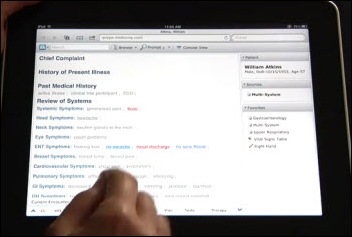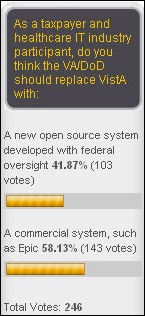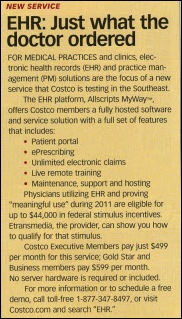HIStalk Interviews Geoff Brown, CIO, Inova Health System
Geoff Brown is SVP and CIO of Inova Health System of Falls Church, VA.

We crossed paths when I asked you about Inova’s system selection, which is underway. What are the strengths and the weaknesses of the systems that you have and what you’re hoping to gain in considering alternatives?
I would probably start out by saying, as opposed to the strengths and weaknesses of it, I think we were an early adopter after Stark relaxation. We jumped in pretty early with an offering. That was back in the days where people tended to prefer to keep their current practice management solution. EMRs were being thought of a separate component, with some people having the option if they wanted to go with an integrated product. Most were more comfortable with their own scheduling and billing systems, whether they were sourcing that or they were doing it out of their practice and had relationships already going. I think that really goes back to around 2007-ish or somewhere in there.
As we went forward, we found two or three things. First of all, the model to market and drive this to the physician community was certainly a different market for us, in terms of the teams you needed in place to go and meet — not with the physician, the physician would want to have it, and that was a key starting point — but typically a lot of these smaller practices had contracted resources that might come in periodically each week. Others might have a secondary support staff that might be an extension of family or relationships. Others might have formal contracted relationships.
There was a significant amount of education that had to happen. As a result of that, over a period of a couple of years, we really learned really how to go at it and to attack that market with various offerings and solutions.
Somewhere along the middle of this, sometime midway in 2009, we didn’t see any requirements for the EMR component not to be integrated with the practice management solution. After the initial kickoff, we got clinical EMR modules moving forward, interfaced with practice management. People started realizing the benefit of, “If I’m going to do this, I need to make sure I do it with a product or a solution that would allow me to automate my workflow on the scheduling and practice management end of the loop, as well as be certified in a go-forward mode with CCHIT at the time.”
That’s really the front end piece of that. Up until we started doing work around the health reform space, you really didn’t have a real huge need to manage your integrated workflow differently. Ambulatory to EHR, the interface process could work fairly effectively for most people.
What’s really made it more important for us to have an integrated solution in place is that we have a very large physician community network. As a result, we want to make sure that we’re able to have a way to extend out the clinical workflow more effectively than we can do now.
We’ve attacking it from a couple of different spaces. I won’t say it’s a weak point, but we’ve been involved largely with HIEs that will certainly meet the CCD-32 standards around interoperability and exchanging from an interface perspective through our HIE in delivering results back and forth to the practices. That process works good, but what we discovered — and this has been a different tier of maturity for us, having jumped in a little early, at least here in our market — is that you can’t make that data actionable now. As much as everybody talks about the Continuity of Care Document and the exchange process, many other vendors weren’t really doing that at the time.
We’re just now starting to see the practices being on release versions that will support that. We’ve been just doing the push-pull type of results delivery, versus having a really smart bi-directional type of a population of clinical information that can be discrete in nature in that you could put rules around and make it actionable in other ways.
That’s really a desired state we hope to get to. I think there are two tracks to get there. You can do it through the standards that we’re all moving toward — HIE standards that have been put in place — or you could have an integrated solution. That really is what drove it for us, as opposed to vendor weaknesses and strengths in large markets. We will never have a situation, I believe, at least in northern Virginia, where there’ll be just one solution.
When you signed your deal with GE three years ago, you said that would be the only product you would directly support. What did you learn from that experience?
The GE product would be the only one we would put subsidy assistance around. It was the same platform as our inpatient product. That had the promise of further integration and interoperability progression. Had we had another hospital information system platform, that we would have wanted to stay with whoever that vendor was, simply because of the promise that as releases were released out to us from an upgrade perspective, you know they would be tackling more and more of the interoperability gaps. By definition, you would be bringing your base of EMRs forward in that vein. That’s really why we said that.
Our story to the community has always been that if you worked with a certified EMR, we would work to provide the interfaces to our environment so that you could move to an electronic process with us. We’ve been that way from Day One, but obviously we wanted to press and have at least a certain base of physicians on what our desire tool was, because that certainly would allow us to move a larger piece of the base forward at any given time.
I saw that you just signed what sounded like a pretty big deal with Oracle for business intelligence and that your CEO was saying it will support “value-based personalized healthcare.” What does that mean and what’s the actual nuts and bolts that you’ll need to work with Oracle to make that happen?
We’re doing like many systems are doing. We’re going down a track where we think the future of medicine is your ability to use analytics to help you actually move further and further toward personalizing care, whether it’s through the improvements that are happening in the genomics environment … again, there’s a huge amount of data that you would have to process and then convert into a format that can be used as good information and can be driven by analytics teams around interpreting that information. So that’s one track.
I think the other area that makes this an important track for us is we are a large system with many disparate applications. As a result of that, we think that there will always be a number of research databases and other applications that fall outside of our traditional transactional systems that are managed through IT. As a result of that, as you’re moving toward better standardization, better evidence-based practice, that you need to pull out … an example of that might be a process we are developing an in-house what we call Inova Broker, which allows us to take data between a disparate environment into our core hospital information system and coded allergy data.
We learned is that allergies are collected at various access points within our organization. However, we had different standards of practice around how comprehensive that was, and when changes were made, how we managed those changes through all of the other key points in our operation. There’s been rigor around how we populate things — how we actually map from one application to another so the data is normalized.
The Oracle HTB project is allowing us to build a repository that has mapped information from each of these applications. We can then write use cases to identify patterns of patients based on certain results. We give our case management folks and others a front-end look at patients we might need to manage across our system, as opposed to waiting until the end of the day and doing queries. We may be able to do some of this identification real-time up front and get a start on making sure we meet some of the quality core measures we may be emphasizing.
As we build this infrastructure around our partnerships and around the data that we generate or exchange within our HIE framework, that will be a central hurdle for us to manage that. We hope to offer opportunities for our community physicians if they participate and follow certain policies that we hope to establish. For those that like to participate in forms of research or clinical trial work, they’ll be able to be a part of this ecosystem here.
It sounds like the projects that you’re working on are based on strategic organizational decisions at the Inova corporate level. Backing up to that, what are the main elements of Inova’s strategic plan and what IT functions get handed down to you to support them?
We’ve had a number of strategic planning sessions. As a result of that, we have mapped where we needed to be as an organization. Some of the things you see and hear us doing are around just being able to manage the flow of patients more effectively across our continuum of care. We actually were doing that well, but if you were to ask me if it was all connected in a way that would be seamless to patients, be workflow smoothly for our physicians as they’re trying to manage their patients … there are some opportunities for us to improve on the handoffs from the hospital environment out to the various ambulatory care settings that we manage, whether that be the physician practices, whether they be home health, or whether that be even some of the joint ventures partnerships we have where patients flow from one setting.
They might not be exclusively in an Inova setting. However, the appearance and the workflow is a coordinated workflow. When they get scheduled, maybe there are multiple steps that can be eliminated in that chain if you had an accident or you needed to have an MRI done.
In some settings, you might have to schedule something unless it’s an emergency, a few days later or a week later. However, we’ll give you the ability through this network or this ecosystem to look at other options if you’re willing. We have these resources available across the continuity of care that we manage with our partners and within our organization. We can give patients and physicians options to get people being seen now or same day, same week, etc. based on the convenience factor for them.
It’s really a whole process around just making the healthcare more fluid. Making access for our patients work more effectively, and in doing so, increasing utilization in ways that we would never be able to address.
You’re on the board of Nova RHIO. How important is interoperability on what you’re trying to accomplish at Inova?
We’re doing a pilot project right now in the ED. It really is around patients when they present in the ED. We’re able to go out as they’re being triaged and check their medication list and compare it with what they’ve told us. The importance of that, based on their allergies and other information that we may or may not have or that they presented just now, is to have a much better profile on the front end.
We’re also talking about other projects in the RHIO that are geared toward getting patients online more effectively with versions of their health record. What we found is the community — folks like you and I, we’re close to it, but when you get into certain elements of the community, people have access to all types of services. But it’s very challenging for most of them to really operationalize those things. The RHIO is coming up with a series of electronic solutions that might be a service or benefit to providers, but also have an element that helps drive it in the Northern Virginia community to a point that they’re able to have their information and access it very easily and share throughout the Northern Virginia space.
At a state level, there’s a certain amount of reporting that will need to happen on a monthly basis. Virginia was one of the states with an HIE grant. What we decided to do, at least here in the state of Virginia , is that Virginia will never be an HIE of its own, but it will require any HIE that is doing business in the state to report to them on whatever the cycle will be and that they comply with certain standards and report to those standards. Virginia can then take all of those feeds and then bring them together in a way that will allow us to do one report out for the Commonwealth.
That’s the real direction that we’re headed here in Virginia. The RHIO will be one of many RHIOs. We have three that actually do work now in the state. I won’t mention them by name, but there are three organizations that have been doing some work. We think there are others that are signing folks up now as well. They can go about the business of competing and having the best programs with the providers that they’re able to sign, but we’ll record them through a single series of standards into the state.
The state will then be responsible for getting their information out as the federal reporting or electronic reporting really start to kick in. The Northern Virginia RHIO’s mission s to help the citizens here in Northern Virginia maximize their ability to receive good care and also manage whatever their requirements are.
Any final thoughts?
It’s a very challenging time. What we’ve learned in being early players with some of the commercial products is that there’s a tier process of maturity that needs to happen between a health system and its community of providers — physicians and other relationships. For instance I’ve learned that your best customer sometimes in this EMR arena is someone that has played around with having electronic solutions, regardless of what product they had. They’re much more educated the second time around the workflow requirements, the commitment to the practice, the commitment to the communication and network activities that have to be in place to make the process work effectively and efficiently.
That’s what we’re starting to see now. That informed client or customer or physician group that has been dilly-dallying in the early days of the EMRs or EHRs. Now they’re going in this second pass much more aware of the type of services they need to have in place, the type of technology support they need to have in place, and quite frankly a lot more aligned and around those individual physicians that are looking to modernize and update their practices to take advantage of these new technologies. That’s the one change that I’ve seen, and that didn’t happen overnight. That happened through levels of maturity you get with moving toward any new platform.




 I’ve run reader-provided hints over several months that Allscripts EVP/CTO John Gomez was planning to leave the company. That became official on Wednesday, when Allscripts
I’ve run reader-provided hints over several months that Allscripts EVP/CTO John Gomez was planning to leave the company. That became official on Wednesday, when Allscripts 






 “The eHealth boondoggle continues,”
“The eHealth boondoggle continues,” 







































 From Quilmes Boy: “Re: Google Health. Just heard a rumor that they are not pursuing development or sales.” Unverified, but strongly suggested by the Wall Street Journal as CEO Eric Schmidt steps aside as CEO to make way for co-founder Larry Page. If they back out of Google Health, that ought to have a major effect on … well, nobody. PHRs are the consumer versions of EHRs — potentially useful technologies that, rightly or wrongly, aren’t all that attractive to their target audience in their current form.
From Quilmes Boy: “Re: Google Health. Just heard a rumor that they are not pursuing development or sales.” Unverified, but strongly suggested by the Wall Street Journal as CEO Eric Schmidt steps aside as CEO to make way for co-founder Larry Page. If they back out of Google Health, that ought to have a major effect on … well, nobody. PHRs are the consumer versions of EHRs — potentially useful technologies that, rightly or wrongly, aren’t all that attractive to their target audience in their current form. 






 Apple
Apple 











RE NEJM piece: He shouldn’t future-conditional with “they can retreat, which might mean abdicating medicine’s broad public role, perhaps in…